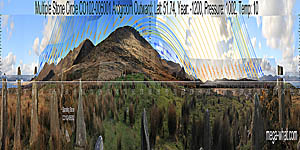 South is indicated by a break in the western slope of the local hilltop and coincides with a lunar sixteenth [Pic].
North is marked by a flattish block of high ground that forms the centre of a distant dip.
Above the end of an island, above the bottom of the bay [Pic]. It is indicated by an alignment of stones across the circle [Pic].
South is indicated by a break in the western slope of the local hilltop and coincides with a lunar sixteenth [Pic].
North is marked by a flattish block of high ground that forms the centre of a distant dip.
Above the end of an island, above the bottom of the bay [Pic]. It is indicated by an alignment of stones across the circle [Pic].
The official description claims that the axial stone is present, regarding the portals as the central pair of the four tall stones. However, it seems more likely that a rectangular (axial) slab would be missing. If so, then the portals would be two tall stones of similar height, rather than an unmatched pair. This interpretation would also place two similarly matched low pointed stones to either side of the (missing) axial.
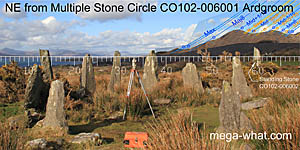
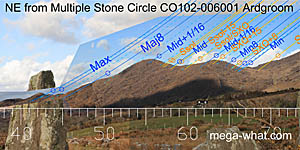 The north-eastern lunisticeLunistices are the most northerly and southerly moons of the month. The lunar equivalent of solstices - more.
zone spans a two topped hill with the central dip marking lunar mid-cycle as well as the limits of the month centred on the summer solstice.
The circle's reverse axis (as interpreted here) is beyond lunar major
standstillLunistice positions vary cyclically over an 18.6 year period but are fairly static for more than a year at either end of the range
but the south portal stone does mark it.
The north-eastern lunisticeLunistices are the most northerly and southerly moons of the month. The lunar equivalent of solstices - more.
zone spans a two topped hill with the central dip marking lunar mid-cycle as well as the limits of the month centred on the summer solstice.
The circle's reverse axis (as interpreted here) is beyond lunar major
standstillLunistice positions vary cyclically over an 18.6 year period but are fairly static for more than a year at either end of the range
but the south portal stone does mark it.
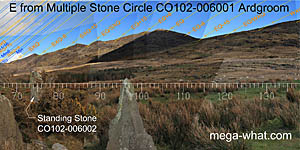 The eastern horizon is quite close and high so that exact observing position would be most important in this direction.
Given this consideration there are good correspondences between solar positions and the various dips and breaks.
The eastern horizon is quite close and high so that exact observing position would be most important in this direction.
Given this consideration there are good correspondences between solar positions and the various dips and breaks.
 To the south-east, winter cross-quarters are at one end of the hilltop and lunar minor standstill at the other.
This horizon is so high that southern lunistice moon rises cannot be seen for about seven years around the major end of the cycle.
To the south-east, winter cross-quarters are at one end of the hilltop and lunar minor standstill at the other.
This horizon is so high that southern lunistice moon rises cannot be seen for about seven years around the major end of the cycle.
An alternative "axial" view indicates minor standstill [Pic].
Due south coincides with lunistice rises at a sixteenth division of the cycle [Pic].
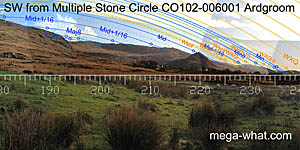
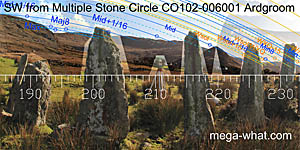 Right of south, any moons appearing from the local ridge have already passed the zenith and are descending towards their settings into further south-western ridges.
Major standstill lunistices are only briefly visible crossing a sharp notch.
Minor standstill is across a distant peak visible through a nearer dip and the midpoint is on a local hilltop.
Right of south, any moons appearing from the local ridge have already passed the zenith and are descending towards their settings into further south-western ridges.
Major standstill lunistices are only briefly visible crossing a sharp notch.
Minor standstill is across a distant peak visible through a nearer dip and the midpoint is on a local hilltop.
One step further around and the officially accepted circle axis indicates lunar major eighth with a pointed axial stone [Pic]. This is probably deliberate but is it the main axis?
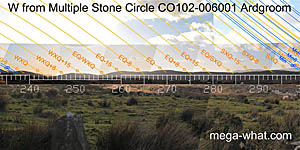 In the west, the equinox is on a hilltop. Winter cross-quarters are marked by a dip in a distant hilltop over a nearer dip at the end of the ridge.
Summer cross-quarters are a quarter-month beyond the useful end of the ridge, at a distant break.
Equinox / cross-quarter midpoints both get good marks.
In the west, the equinox is on a hilltop. Winter cross-quarters are marked by a dip in a distant hilltop over a nearer dip at the end of the ridge.
Summer cross-quarters are a quarter-month beyond the useful end of the ridge, at a distant break.
Equinox / cross-quarter midpoints both get good marks.
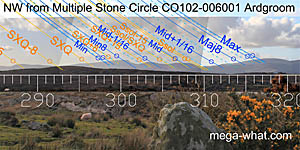 The north-western lunistice zone starts and ends on slopes to either side of a double topped hill.
Solstice sunset is into a dip, as the the solstice / cross-quarter midpoint.
The north-western lunistice zone starts and ends on slopes to either side of a double topped hill.
Solstice sunset is into a dip, as the the solstice / cross-quarter midpoint.
An anomalous tall, pointed south sidestone may be aligned with the tallest stone to indicate lunar mid-cycle in this direction [Pic].
 The standing stone is a tall slab, just a few metres east-north-east of the circle.
Its position has not been independently surveyed but differences would only be significant on the nearest horizons and then only subtly so.
Possibly erected by the circle builders but later colonists of the area seem the more likely candidates.
The standing stone is a tall slab, just a few metres east-north-east of the circle.
Its position has not been independently surveyed but differences would only be significant on the nearest horizons and then only subtly so.
Possibly erected by the circle builders but later colonists of the area seem the more likely candidates.
To the north-east the stone's pointed top can be brought below the skyline in the direction of lunar major eighth [Pic]. It cuts the south-western skyline from anywhere close but the axis is towards winter solstice sunsets [Pic].
There are many more bronze-age monuments in the area. The nearest surveyed sites are:
- Cashelkeelty Stone Circles & Row c.3km north-north-east
- Barrees Stone Pair c.8km south-west
References
- Archaeological Survey of Ireland, record details. www.archaeology.ie/archaeological-survey-ireland
- POWER, D. et al. 1992 Archaeological Inventory of County Cork, Volume 1: West Cork. Dublin: Stationary Office. p20, no.41 & p45, no.232.
- Ó'NUALLÁIN, SEÁN 1984 A Survey of Stone Circles in Cork and Kerry. Proceedings of the Royal Irish Academy 84c:1-77, p18, no.21.
- RUGGLES, C.L.N. 1999 Astronomy in Prehistoric Britain and Ireland. Newhaven & London: Yale University Press. No.ASC31.
